THE PLAN TO SEGREGATE BED-STUY (1937)
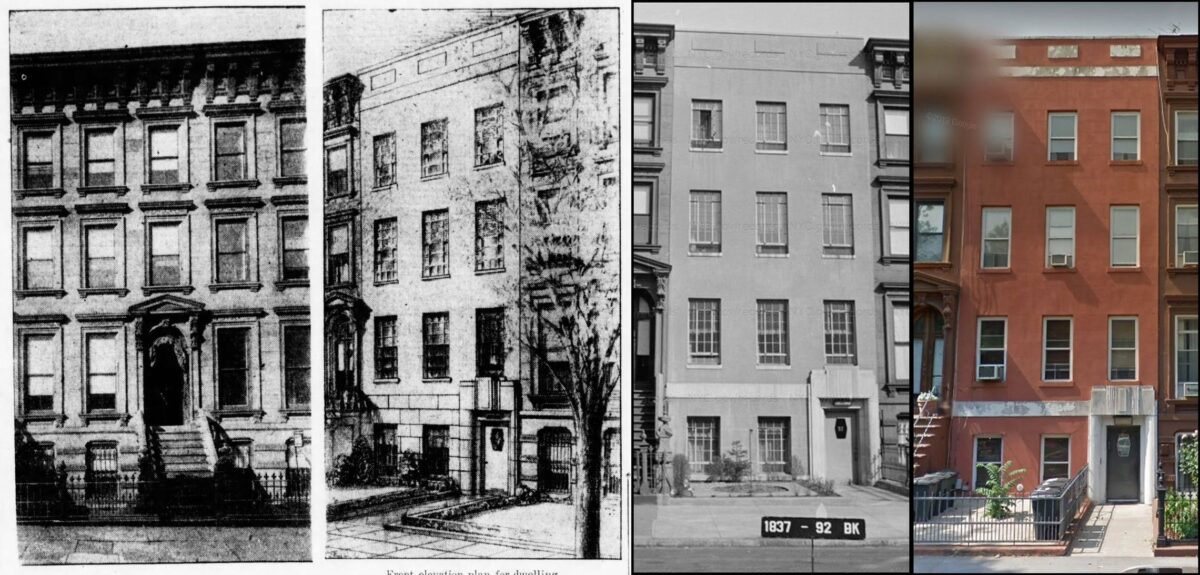
Brownstone Detectives investigates the history of our clients’ homes.
The story you are about to read was composed from research conducted in the course of one of those investigations.
Do you know the history of YOUR house?
********************************************************************************************************************************
In 1937, much of Brooklyn’s brownstone stock was reaching its limits.
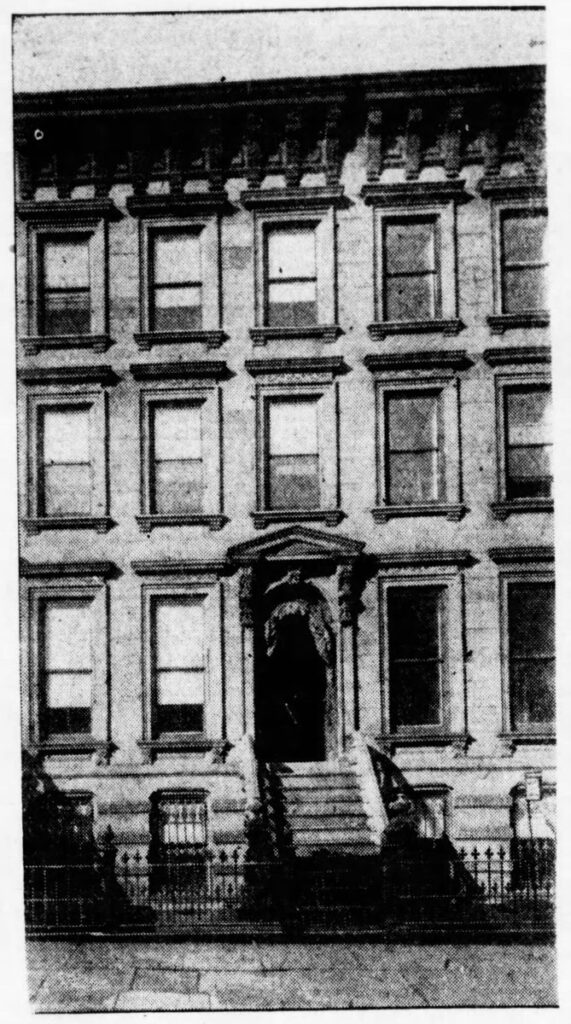
Its townhouses were, on average, approximately 50 years old and, in the eyes of many residents and brokers, outmoded of interior and unattractive of exterior. In fact, residents of certain sections of Brooklyn were beginning to move out of the older sections with the ancient brownstones, in favor of the newly constructed apartment buildings – or simply to other outlying sections of the borough.
There were those residents, however, who felt that they saw a bigger problem, an over-arching trend that, unchecked, had the potential to destroy investment, send house values spiraling downward, and force them to move out of a community where they – and their families – had lived for generations.
For these residents, the problem fell less into the category of an ageing housing stock than into that of the lot of outsiders – those of a different economic class, certainly those of a different race – who were already beginning to move into them.
The problem of the outdated housing stock, while real, was not the sole impetus to modernize. Rather, that incentive came from a fear of an undesirable population that must, at all costs, be kept at bay.
It was, thus, that a move kicked into high gear around this time to update and modernize those well-located brownstones – to keep a certain population in and a certain population out.
MODERNIZATION AS A FORM OF SEGREGATION
In a report issued around this time by a new group known as the Brooklyn Better Housing Committee (BBHC), it was indicated that “slum prevention was equally important with slum clearance,” and that “an immediate organized program” to modernize the “well located and well constructed existing buildings in our Borough” was necessary.
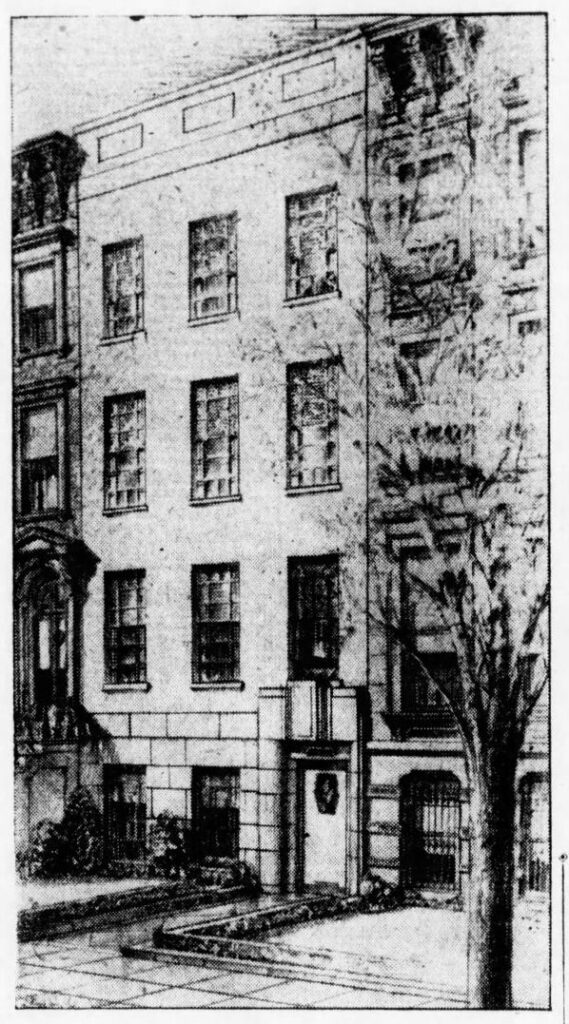
The writer of that report, Herbert L. Carpenter, a civic minded Brooklyn resident, a member of the finance committee of the Brevoort Savings Bank, and the chairman of the BBHC, itself, reasoned on this point that such rehabilitation of the housing stock in certain sections of Brooklyn would effectively “retain their desirable population” and “save themselves from slipping into slum occupancy and completely demoralized values.”
The plan of action laid out by the BBHC was a “safeguard for business” and was ostensibly sold as a plan to “provide moderate cost housing units on a basis that will restore values in our residential and business sections.”
It may have been a targeted economic plan, but it was also a plan aimed at maintaining segregation.
TAKE THE A TRAIN (FROM HARLEM TO BROOKLYN)
What was not detailed in Carpenter’s report was specifically the thought that was on the mind’s of many white Brooklynites at the time – the fear of mass migration of blacks into the neighborhoods of the white residents of Brooklyn.
Recent events had been unfolding that were causing this very trend to exist – and increase. The Depression, in particular, was having the negative economic impacts of forcing down rent rolls, as well as turning the formerly employed into the jobless on the streets.
As a result there was a (perceived, at least) scramble for smaller pieces of the pie.
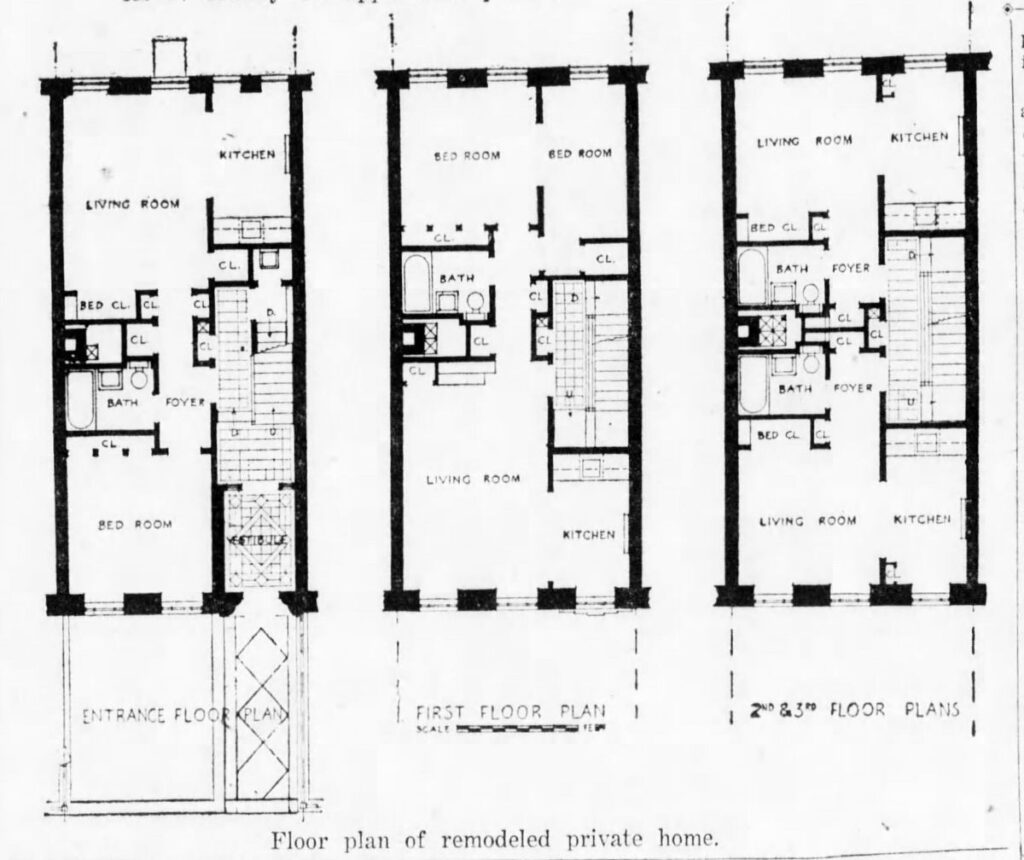
One of the singular events, however, that, in the eyes of those Brooklynites, was changing everything for the worse was the extension of a mode of mass transportation from Harlem to Bedford-Stuyvesant.
The Eighth Avenue Express A Train, which had its origin in Harlem and wound its way down through Manhattan, had recently extended its lines into Brooklyn.
Residents of the overwhelmingly black Harlem, which was, itself, becoming overcrowded, saw in this extension an opportunity to move out of the aging brownstones of a congested section of town and to find space, more modern facilities, and jobs in a roomier Brooklyn.
The timing of the arrival of the A Train in Brooklyn with that of Carpenter’s report, thus, was no coincidence.
In fact, by 1933, the A Train had already extended across the East River to Jay Street-Borough Hall in downtown Brooklyn. Just a few years later, in 1936 – just as the BBHC was beginning to study the issue of modernizing housing – the line had opened all the way to Rockaway Avenue.
Within that line, sat No. 27 Halsey Street.
No. 27 AS THE VANGUARD
To excite and encourage that “desirable population” in Brooklyn, Carpenter knew he had to create an exhibit, a centerpiece that would show property owners the potential for such a plan. In short, he had to boost the courage of the troops – whose courage was certainly flagging.
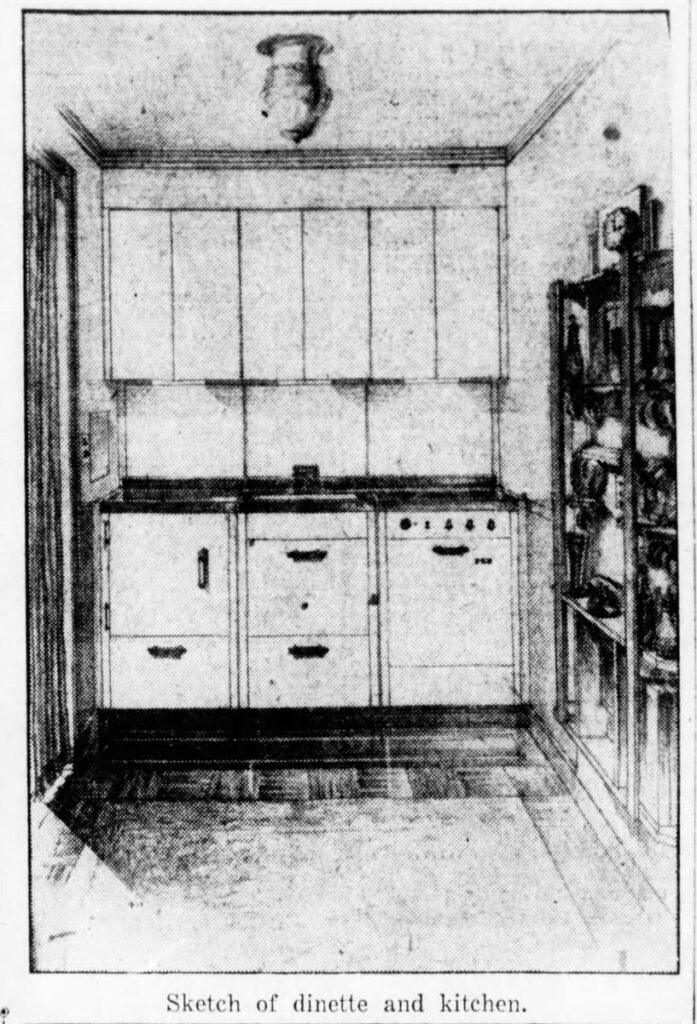
So, along with the bank with which he was associated, he identified one of the brownstones in its portfolio of foreclosed properties, No. 27 Halsey Street, and made this brownstone that front line. Taking control of the brownstone and its future (on behalf of the bank), he made the argument that its rehabilitation would turn the tide and keep Brooklyn’s desirable population firmly ensconced in their brownstones.
He was also the plan’s publicity man, placing stories in many of the major newspapers of the day.
“To demonstrate what can be done to redeem old three and four-story and basement dwellings by profitable rehabilitation,” noted a story in the Brooklyn Daily Eagle (which likely mimicked the words in his report), “arrangements have been made for the complete modernization of the typical private residence, 27 Halsey St., the plans for which have been developed jointly by the Brooklyn Better Housing Committee and the Brooklyn Edison Company.
“For the past two years the BBHC has been analysing this problem and endeavoring to safeguard the business and future of may of our culturally located areas, and to provide moderate cost housing units on a basis which will restore values in our residential and business sections, and make the investments involved profitable to all concerned and also add further to employment and general recovery.
“The 27 Halsey Street building will be probably different than any other improvement of its kind in the country, and in this case will have two 4-room and bath apartments, and four 2-room and bath apartments. The very latest standards of quality production, heating, kitchen, bathroom, steel stairways, and other units will be used. The old typical brownstone front will give way to one of the most attractive architectural developments in the Borough with a modern, but not over modernistic stone entrance.”
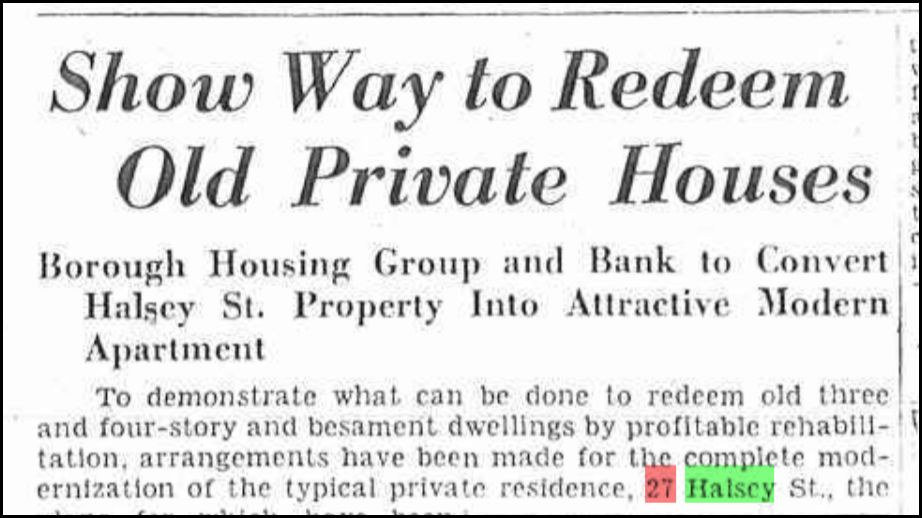
Then came the crux of Carpenter’s argument – how current homeowners could reproduce Carpenter’s success.
“Although this building will show the latest development in the conversion of such a building into a six-family apartment, plans will be available to show just how similar buildings, either individually or in groups, may be modernized into single, modern one-family buildings, the novel convertible home for income purposes, the duplex two-family, or the other combinations which may prove economical or desirable in individual cases.”
Aside from the economic-talk and the indicators of a changed economy through the mass modernization of brownstones in certain sections of Brooklyn, the incentive for the modernization was still the same.
To whit, Carpenter’s architect, in a booklet published to explain the project, noted his feelings on modernization:
“This actual demonstration of the reconstruction of 27 Halsey St., it is hoped, will assist in the solution of a great civic problem which faces Brooklyn, which is the continuing migration of many of its old-time residents to other localities in the suburban areas and the consequent decline in desirable population and change in character of the old established neighborhoods.”
Thus, the die had been cast.
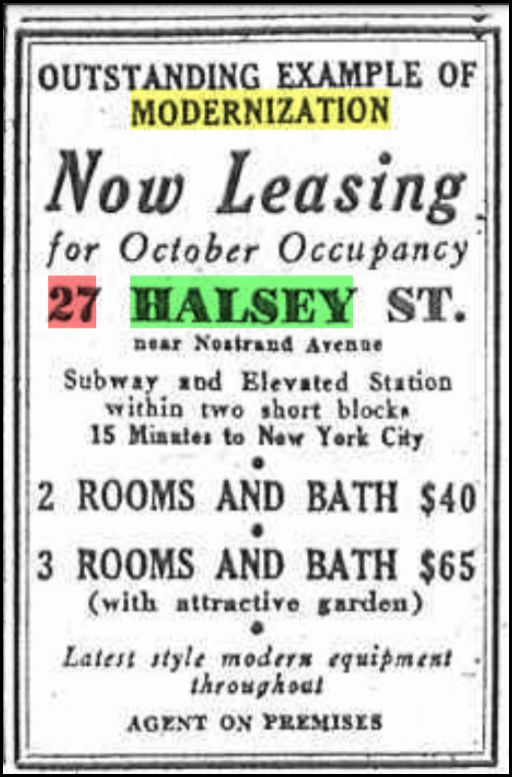
POSTSCRIPT
According to the Brooklyn Daily Eagle, the apartments in No. 27 Halsey rented rapidly.
The Bank was thus renovating two other brownstones into apartment houses at No. 11 Halsey and No. 1 Brevoort Place.
“All of the apartments in the house at 11 Halsey St. have been rented,” noted the Eagle, “while all but one of those in the 1 Brevoort Place house are now occupied.”
While Carpenter’s plan may have had limited successes on a small scale, his efforts (and those of the bank and the BBHC) were simply too little too late to combat the problem that he felt existed.
While his plan may have shown a way forward for some homeowners, it proved ineffective in achieving its grand purpose of stemming the tide of African-Americans who sought out a better quality of life in Bedford-Stuyvesant – and in its brownstones.
While until the 1930s, blacks made up less than 1.4% of Brooklyn’s population, by 1950, with the A Train’s massive moving capacity, along with such economic incentives as a flurry of new jobs at the Brooklyn Navy Yard during the war, the number of black residents, in Bedford Stuyvesant alone, had risen to about 55 percent of its population. By 1960, 85 percent of the population was black.
Bed-Stuy’s African American population, though, changed Brooklyn in many way as it “built the neighborhood into the cultural center of black Brooklyn,” noted The Bridge, in a review of Kay Hymowitz’s book, The New Brooklyn, “That culture may not have had the national reputation of the Harlem Renaissance, but it was nonetheless a source of solidarity, pleasure, and commerce that still shapes the local population’s sense of itself.”
———————————————————————————————————————–
 Brownstone Detectives is an historic property research agency. Our mission is to document and save the histories of our clients’ homes. From our research, we produce our celebrated House History Books and House History Reports. Contact us today to begin discovering the history of your home.
Brownstone Detectives is an historic property research agency. Our mission is to document and save the histories of our clients’ homes. From our research, we produce our celebrated House History Books and House History Reports. Contact us today to begin discovering the history of your home.